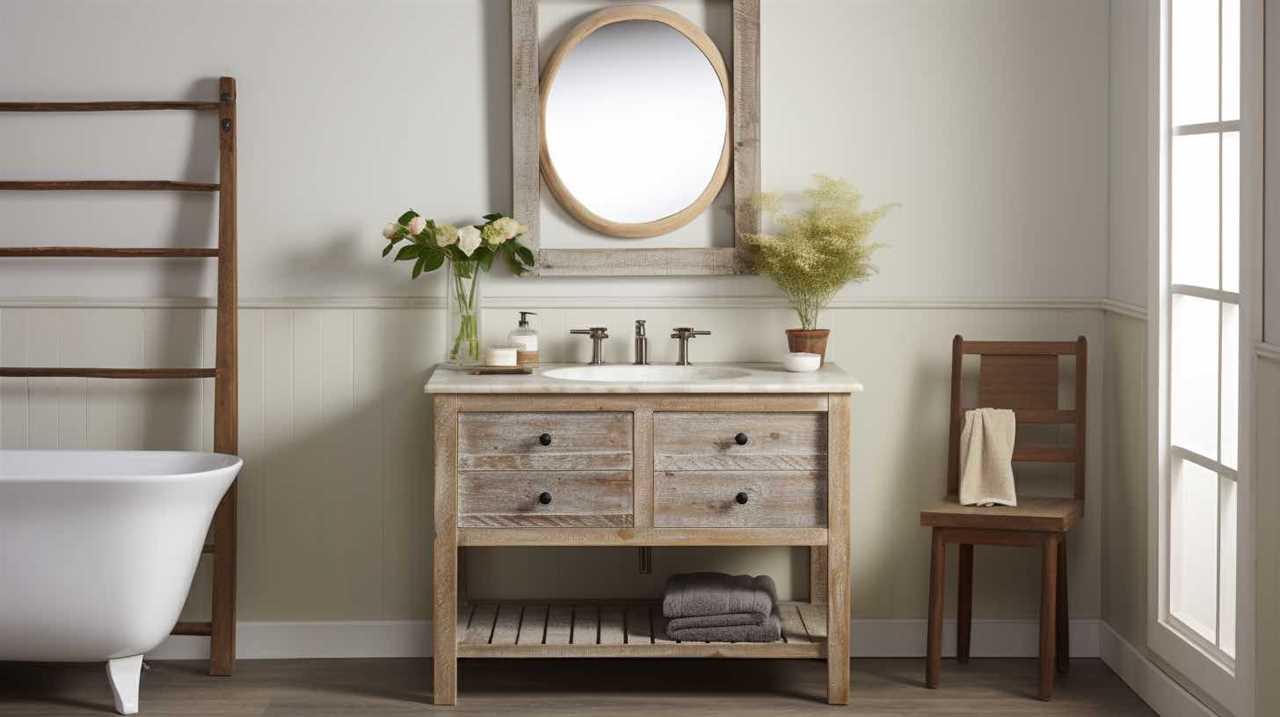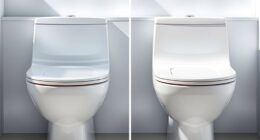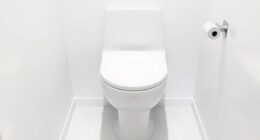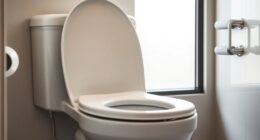Do you find yourself frustrated with stubborn clogs in your bathroom drain?
Well, we’ve got news for you – those clogs are more than just a minor inconvenience. In fact, they can wreak havoc on your drain performance and lead to costly repairs.
From hair to soap scum and mineral buildup, these culprits can cause serious blockages.
But fear not! In this article, we’ll share preventative measures to keep your bathroom drain clear and flowing smoothly.

Get ready to master the art of a pristine drain!
Key Takeaways
- Hair buildup, soap scum accumulation, mineral deposits, and foreign objects are common culprits of bathroom drain clogs.
- Hair, especially long and thick hair, can significantly impact drain performance, while using a drain cover or screen can help catch loose hairs.
- Soap scum, formed by soap mixing with hard water minerals and body oils, narrows drain pipes, traps debris, and promotes bacterial growth, emphasizing the need for regular cleaning.
- Mineral buildup from hard water, which reacts with soap scum and other substances, can lead to clogs, requiring specific measures to address hard water issues and prevent mineral buildup.
Common Culprits of Drain Clogs
In our experience, the most frequent cause of bathroom drain clogs is a combination of hair and soap scum buildup. When hair gets caught in the drain, it can accumulate and form a blockage over time. This is especially true for those with longer hair or households with multiple occupants.
Soap scum also contributes to clogs as it can stick to the hair and create a sticky residue that further traps debris. Additionally, foreign objects like toilet paper blockages or small items accidentally dropped into the drain can impede water flow and lead to clogs. These culprits can significantly impact drain performance, causing slow drainage or complete blockages.
Now, let’s delve into the specific impact of hair on drain performance.

Impact of Hair on Drain Performance
When it comes to bathroom drain clogs, hair is a significant factor that greatly affects drain performance. Hair has a tendency to accumulate and form clumps, which can lead to blockages in the drain pipe. To illustrate the impact of hair on drain performance, consider the following table:
| Hair Type | Drain Performance |
|---|---|
| Long and Thick | Poor |
| Short and Thin | Fair |
| Curly and Frizzy | Moderate |
To prevent hair clogs and maintain optimal drain performance, several hair removal techniques can be employed. Regularly cleaning hair from brushes or combs before washing them can help reduce the amount of hair going down the drain. Additionally, using a drain cover or screen can catch loose hairs and prevent them from entering the drain pipe. Finally, periodically using a drain cleaner specifically designed to dissolve hair can help break down any existing clogs. By implementing these preventive measures, one can effectively minimize the impact of hair on drain performance.
The Role of Soap Scum in Drain Blockages
To continue our exploration of bathroom drain issues, let’s delve into the significant role that soap scum plays in causing drain blockages.
Soap scum is formed when soap mixes with hard water minerals and body oils. It gradually accumulates on the walls of the drain pipe, narrowing its diameter and restricting water flow. Soap scum acts as a sticky substance that traps hair, debris, and other particles, further obstructing the drain.

Additionally, soap scum provides an ideal environment for the growth of bacteria, which can produce slimy biofilms that clog the drain even more.
To prevent soap scum buildup and maintain proper drain function, regular cleaning is crucial. Using mild detergents or vinegar-based solutions can help dissolve and remove soap scum. Adequate cleaning also prevents bacterial growth, ensuring a more hygienic bathroom environment.
Mineral Buildup: A Hidden Enemy of Drains
Now let’s shift our focus to the hidden enemy of drains: mineral buildup.
Hard water, which is water that contains high levels of minerals such as calcium and magnesium, can lead to the formation of mineral deposits in drains.
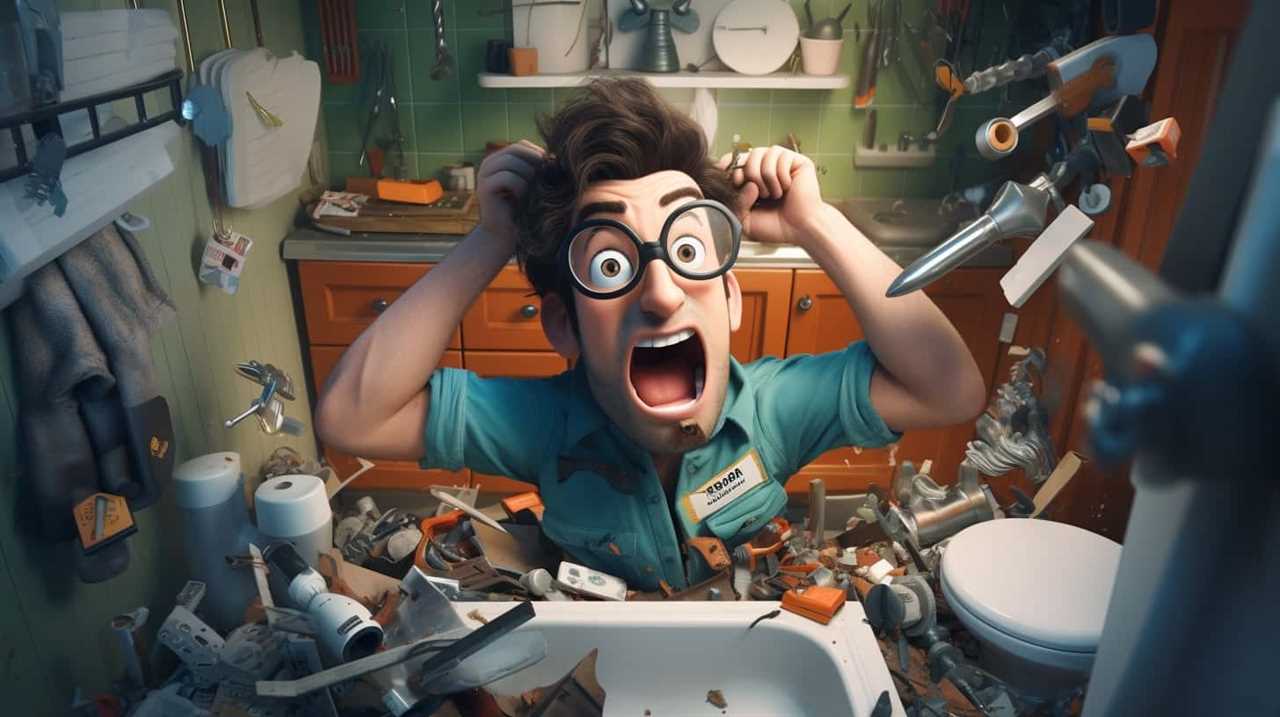
Over time, these deposits accumulate and can cause clogs and blockages.
The minerals in hard water can react with soap scum and other substances in the drain, creating a hardened and stubborn buildup that’s difficult to remove.
This mineral buildup can also make cleaning efforts ineffective, as traditional cleaning methods may not be able to dissolve or break down the mineral deposits.
Therefore, it’s important to address hard water issues in order to prevent mineral buildup and maintain the proper functioning of drains.

Preventative Measures for a Clear Bathroom Drain
To maintain a clear bathroom drain, we can take preventative measures. By implementing these measures, we can minimize the risk of clogs and ensure efficient drainage. Here are some effective methods:
- Regular cleaning:
- Use chemical cleaners: Opt for drain cleaning products that are specifically designed to break down residue and prevent buildup. Be sure to follow the instructions carefully.
- Natural remedies: Consider using natural alternatives such as baking soda and vinegar. These can help dissolve grease and grime without causing any harm to the environment or your pipes.
- Hair traps:
- Install a hair trap: Place a hair trap over the drain to catch hair and prevent it from clogging the pipes. Regularly clean the trap to maintain its effectiveness.
Frequently Asked Questions
How Can I Remove a Stubborn Drain Clog Without Calling a Plumber?
We can remove a stubborn drain clog without calling a plumber by utilizing various unclogging methods and DIY drain cleaning techniques. These methods are effective, cost-saving, and allow us to maintain a functional bathroom drain.
Can Using a Drain Cleaner Regularly Damage My Pipes?
Using drain cleaner regularly poses potential risks to the safety of our pipes. The long-term effects of drain cleaner can lead to damage, deterioration, and even costly repairs. It’s important to consider alternative methods for maintaining our bathroom drains.
Is It True That Pouring Hot Water Down the Drain Can Prevent Clogs?
Pouring hot water down the drain is an effective method to prevent clogs in the bathroom. It is a reality, not a myth. The high temperature helps dissolve grease and other debris, keeping the pipes clear.

What Are Some Alternative Methods to Prevent Hair From Clogging the Drain?
To prevent hair clogs in the bathroom drain, we can employ various DIY drain cleaning methods. One effective technique is using a drain snake or a wire coat hanger to remove hair buildup.
Are There Any Natural Remedies to Unclog a Drain?
There are various natural remedies and DIY methods to unclog a drain. These can include using a mixture of baking soda and vinegar, pouring boiling water down the drain, or using a plunger.
Conclusion
In conclusion, maintaining a clear bathroom drain is essential to prevent clogs and ensure optimal performance.
Hair, soap scum, and mineral buildup are common culprits that can hinder drain function. Regular cleaning and preventative measures such as using drain covers and avoiding excessive product usage can help keep your drain running smoothly.

Just like a well-oiled machine, a properly maintained bathroom drain will flow effortlessly, like a river carving its path through a canyon.






